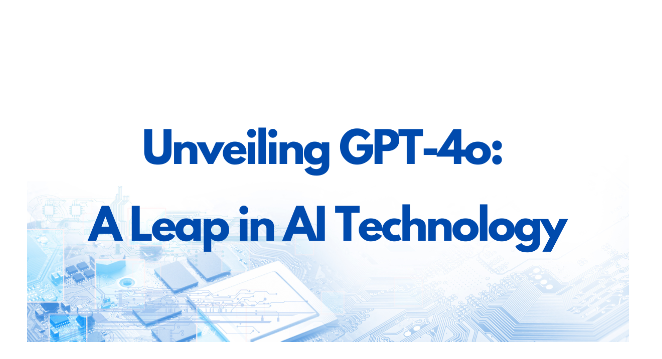Unveiling GPT-4o: A Leap in AI Technology

Introduction to GPT-4o
OpenAI has once again pushed the boundaries of artificial intelligence with the release of GPT-4o, a model that promises to redefine how humans interact with machines. This cutting-edge model incorporates advanced multimodal capabilities, enabling it to understand and generate content across text, voice, and visual inputs with unprecedented fluidity and precision. Designed to function seamlessly across various interfaces, GPT-4o aims to democratize AI technology, making it more accessible and intuitive for users around the globe. This introduction explores the profound enhancements and capabilities that GPT-4o brings to the table, setting the stage for a new era where AI becomes an integral part of our daily digital interactions.
What new contents does GPT-4o bring?
Revolutionary Multimodal Integration
GPT-4o takes a giant leap forward by integrating multiple forms of communication:
- Text Analysis and Generation: Enhanced natural language processing for more accurate and context-aware responses.
- Voice Recognition and Interaction: Real-time processing and responses to spoken commands.
- Visual Understanding: Ability to interpret and analyze images dynamically.
Unparalleled Processing Speed
The model boosts efficiency, enhancing user interaction with technology:
- Faster Response Times: Minimized lag in interactions, approaching real-time communication.
- Improved Computational Efficiency: Optimal use of resources, enabling quicker and more accurate responses.
Expanded Accessibility
GPT-4o is paving the way for broader accessibility in AI applications:
- Language Diversity: Supports extensive multilingual capabilities, removing language barriers.
- User-Friendly Interfaces: Intuitive designs that cater to both tech-savvy users and novices.
How does GPT-4o compare to other models?
GPT-4o is not just an improvement over its predecessors; it’s a benchmark for future AI developments. This section examines how GPT-4o stands out from previous models in key areas:
Enhanced Multimodal Capabilities
GPT-4o uniquely combines text, audio, and visual data processing, offering a more holistic and integrated approach than earlier models, which focused primarily on text.
Increased Efficiency and Speed
It operates at double the speed of GPT-4 Turbo, demonstrating not only enhanced capabilities but also significant improvements in processing efficiency and cost-effectiveness.
Broader Accessibility
With its user-friendly design and support for over 50 languages, GPT-4o extends the reach of advanced AI to a global audience, ensuring that more users than ever can benefit from its capabilities.
What previous questions does GPT-4o address?
The development of GPT-4o by OpenAI responds to a series of longstanding user concerns and technical limitations evident in previous AI models. This latest model targets specific areas where users have sought improvements, including interaction quality, adaptability to different formats, and ease of use. GPT-4o’s design and capabilities provide clear answers to these questions, demonstrating OpenAI’s commitment to evolving AI technology in response to user feedback and changing technological landscapes.
Enhanced Interaction Quality
GPT-4o addresses the robotic and often unsatisfying interaction experience associated with previous AI models. With advanced natural language processing and emotional intelligence capabilities, GPT-4o offers interactions that feel more human-like, providing responses that are contextually relevant and emotionally aware. This significant improvement in quality makes interactions with AI more engaging and satisfactory for users.
Improved Adaptability Across Formats
One of the critical challenges previously was the AI’s limited ability to handle various data formats simultaneously. GPT-4o eliminates these limitations by integrating voice, visual, and text data processing capabilities within a single model. This adaptability allows GPT-4o to function effectively in diverse settings, enhancing its usefulness across different industries and applications.
Ease of Use and Accessibility
Earlier models often posed challenges for non-technical users due to their complex interfaces and specialized requirements. GPT-4o confronts these issues directly by offering a more intuitive user experience and reducing the technical barriers to entry. This approach not only broadens the potential user base but also ensures that AI technology can benefit a wider spectrum of society.
Future developments expected in AI from OpenAI?
As AI continues to advance, the future developments from OpenAI are anticipated to be both innovative and influential. Building on the foundation laid by GPT-4o, future initiatives are expected to further enhance AI’s role in society:
- More sophisticated ethical AI frameworks.
- Deeper integration into sector-specific applications.
- Continued enhancement of user interfaces.
- Greater emphasis on sustainable AI development.
Future of AI with GPT-4o
The introduction of GPT-4o represents a pivotal moment in the trajectory of artificial intelligence. With its advanced capabilities, this model not only enhances current applications but also opens up new possibilities for AI in everyday life and professional settings.
The future of AI with GPT-4o will be more personalized, intuitive, and accessible that can perform a wider range of tasks with greater autonomy and efficiency. But it should be known that this does not mean that ChatGPT-4 will become a NSFW AI though NSFW content is popular recently. As GPT-4o and subsequent models evolve, we can expect AI to become a more integrated, influential, and indispensable part of our world, transforming industries and enhancing human capabilities in unprecedented ways.


